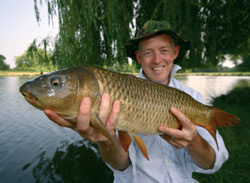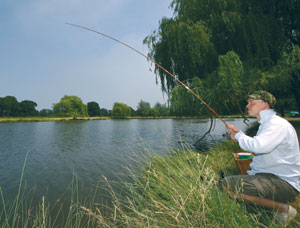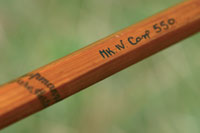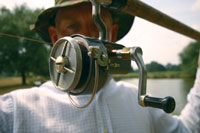Modern baits and antique tackle meet as John Andrews goes in search of tench in London’s historic Bushy Park. But it doesn’t quite go to plan…
The day is hot. Not as hot as the previous day which had broken all records by becoming the hottest July day on record with temperatures reaching 36.3 degrees centigrade. But it’s still well up in the 30s.
London is baking. The nights are feeling almost hotter than the days. Sleep is broken and the sound of rain is a dream.
When I walk into my local tackle shop, Ashpoles on Newington Green, Julian and Lionel look at me as if I’m mad to go fishing. And when I tell them I’m fishing in a London park Julian cracks a wry smile.
During heatwaves London’s parks, those often referred to as ‘the lungs of the city’, are choked by people seeking refuge from the heat. All of them gravitate towards the water. So who in their right mind would want to fish in a place where the walk to the swim was through a shanty town of deckchairs and picnic blankets, and where your chosen spot resembles a paddling pool?
Not me, that’s for sure. Normally I want solitude when I fish and head out of town. But, with the motorways close to melting, I feel it’s the perfect opportunity to stay in London to fish.
For once, though, I’m not going to fish the Thames. Call it superstition but I feel my season hasn’t begun until I’ve caught a tench. Only then can I turn my back on ponds and lakes and head for the river.
Since June 16th I’ve fished at Blenheim Palace and at Frensham Great Pond. And all I took was a perch of about half a pound.
I’ve been told there are tench in the ponds at Bushy Park and although it’s a London park, and a royal one at that, it’s also sufficiently big and wild enough to be full and yet feel empty.
Bushy Park lies to the south west of London near Kingston-Upon-Thames. It’s a mile long and over two miles wide, and was originally created by King Henry VIII’s close adviser, Cardinal Wolsey, in the early 16th century, when he enclosed an area of local farmland.
The name Bushy is believed to be a reference to the huge number of hawthorn bushes which were planted in the park to protect the oak trees that Henry VIII used for building his naval boats and the deer he kept for hunting.
There are three ponds in Bushy Park: the Diana Fountain – a circular pond marked by the statue of Arethusa, the goddess of hunting, and designed by Sir Christopher Wren during the reign of William and Mary – the Heron Pond and the Leg of Mutton.
Heron and Mutton both date back to 1680 when Oliver Cromwell, resident at Hampton Court Palace, extended the artificial Longford river (built by Charles I) to create two ponds specifically for fishing.
Indeed, Leg of Mutton was originally known as Oliver’s Pond although its name was later changed due to its shape. The Heron is so named because it’s always been home to those majestic, feathered fish hunters.
The drive into the park is a grand entrance along an avenue of horse chestnut trees, with the Diana statue ahead in the distance. There’s the odd dog walker and runner about, but apart from that mine’s the only vehicle in the car park and once I’ve turned off my engine the silence is immense. In London, too!
As I walk quickly through the bracken to the Leg of Mutton the last of the dawn mist is burning off, and I feel that great sense of anticipation that we all get when we know we will be the first person on the water.
I make my mind up to fish a shallow swim near to the dam with a patch of lilies to the right that’s within easy casting distance. However, even though there are fish cruising and patches of bubbles exploding every now and again, the sun is already quite high in the sky and it’s clear that bites here are going to be at a premium in the bright conditions.
|
|
I fish to the left of the lily pads for a short while, using my antique Bruce & Walker Avon Perfection rod and a classic Paul Cook tench float, with maggots on the hook over a bed of loose-fed casters. But it’s soon clear the fish are not interested.
During my recce two nights previously, a couple of local anglers pointed out that the flow from the Longford river had created a channel down the middle of the pond which, although silty, is over gravel. It’s here that they believe the tench will be during the heat of the day. So I leave my lily swim and stroll down the bank and set up opposite the channel.
You’ll notice that I like to fish with antique tackle. I organise the antique tackle fair and it’s long been a passion of mine; I enjoy fishing with quality old tackle and to catch fish on it gives me a buzz that I just can’t get with modern carbon rods and multi-geared reels.
I try to float fish but the welcoming breeze creates too much surface drag. So I try back shotting, again to no avail.
Frustratingly, I put away the float rod and set up my leger gear, in this case a split cane three-piece Mk IV carp rod, 10ft in length and made by Chapman’s of Ware in the 1960s.
With this I use a Hardy Altex, a fixed spool reel originally designed in the 1930s but latterly made fashionable for stillwater fishing by Chris Yates.
With 8lb main line loaded on the reel I set up a running bomb, stopped using a bead and a swivel with a hook link of about 10 inches. This is the leger rig I’ve used ever since I started legering on Lodge Pond in the late 1970s.
The one change to my original set-up is that I now use a swivel instead of a leger stop, and having learnt the trick of the knotless knot it’s a lot easier than tying 1lb line to the nape of the hook like I used to!
Another thing I’ve kept since the 1970s is my love of the bottle top bite indicator and the Optonic bite alarm. I know alarms are lazy but using one does give the chance to watch the water and keep an eye out for fish while waiting for a bite.
I bait up with a mini boilie, tutti frutti flavour – an incongruous match with old gear – but it’s only the same as putting modern petrol in a vintage car, or at least that’s what I tell myself…
Not long after my first cast doubt creeps into my mind. You know, the usual stuff. Is the bait on? Am I in the right place? Should I have a lucky cup of tea?
 |
| John was not expecting to catch this 6lb carp, his first for 25 years. |
From the initial drag I feel when I reel back in, it’s clear that the lead has been firmly buried in some silt – and with it my bait.
To sort things out I tie my bomb onto a swivelled paternoster on 10 inches or so of slightly lighter line and thread three plastic beads onto the reel line.
By doing this the bomb may still stink in the silt, but the hooklength that I increase to three feet should remain above the silt when it settles. Feeling more confident, I rebait and recast.
Noel Coward once said that only mad dogs and Englishmen go out in the midday sun. But he neglected to mention the fish in the Leg of Mutton pond!
As midday approaches I get a scorching run, bottle top to the second ring and handle back-winding.
I don’t strike in so much as pick up the rod to try and stop the fish. It kites fast to my left in the direction of what looks like a sunken hawthorn bush. I need to halt the run quickly so I apply loads of sidestrain and manage to turn the fish, which now heads in the opposite direction, allowing me to play it in the open water.
The depth of the Leg of Mutton is normally around four feet, but there is a deep layer of silt and a lack of water. Due to the drought it is barely two to three feet deep today so it’s not easy to keep the fish away from the surface.
I play it gingerly, keeping the line tight and letting the cane do the work with a bit of back-winding to look after the runs. It’s obvious this fish is a carp and not a tench.
Once again I do my usual trick of hooking a fish I hadn’t come for. After a spirited fight on my old tackle the fish rapidly tires and is soon resting in the landing net.
It is a lean, bullet of a fish weighing about 6lb. At first it looks like a common that has all the hallmarks of a Leney descendent, a strain that was imported into Great Britain in the 1930s by Donald Leney; they are long, lean and bronzed, and caught from a water where Henry VIII’s stags now bathe.
Unfortunately, try as I might, I cannot get another fish, and as the heat of the afternoon continues to rise it beats me and I decided to pack up.
It turns out that I’ve chosen the hottest July week on record to fish the venue. However, I’ll always remember it as the week when I caught my first carp for 25 years, and from one of the most historic waters in the country.
Venue Fact File
Leg of Mutton Pond, Bushy Park, Surrey
Species: Carp, tench, perch, roach, pike, eels
No of swims: 10 to 15
Rules: One rod per permit, barbless hooks and unhooking mats compulsory. No groundbait, bait boats or night fishing. No pike fishing before October 1st. No pre-season baiting
Tickets: Season ticket only running from June 16th to March 14th inclusive. Adults £20 per permit, one rod per permit (maximum of two permits allowed). Concessions: senior citizens (over 60) £10; juniors (10 to 16) £10; children under nine can fish free but must be accompanied by an adult permit holder. Permit also covers Hampton Court, Longwater and Rick Pond plus Diana Fountain and Heron Pond
Contact: Fishing Permits, c/o Hampton Court Palace, Surrey KT8 9AU or www.hrp.org.uk








